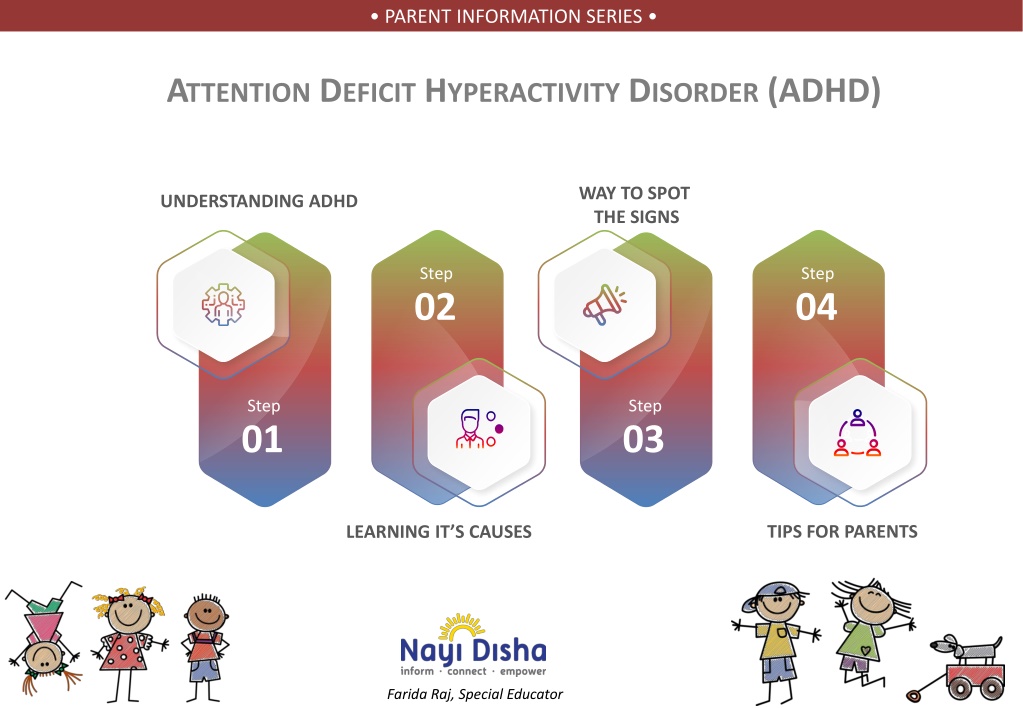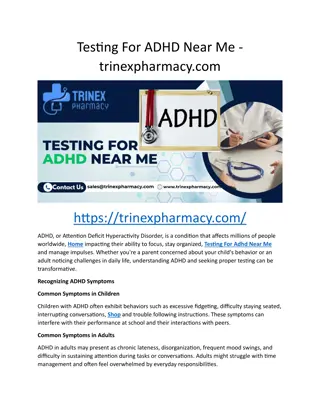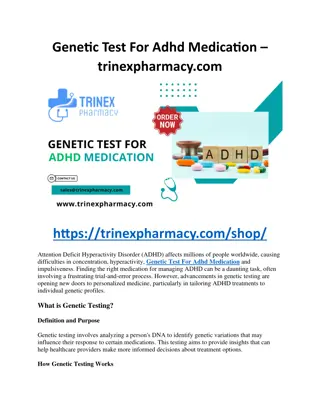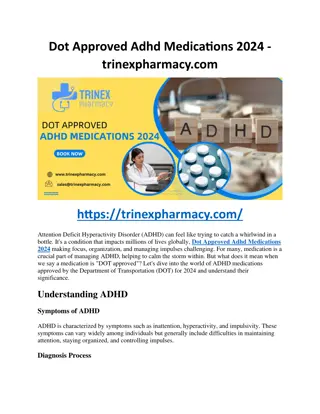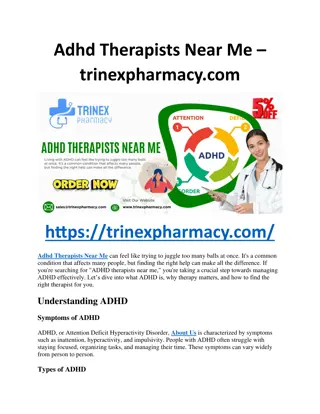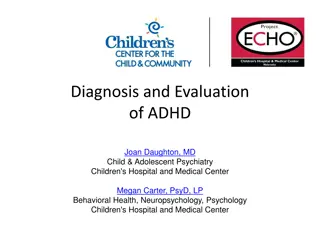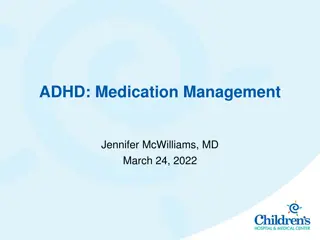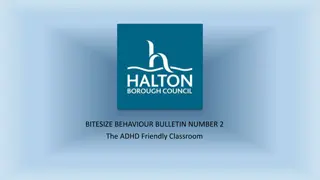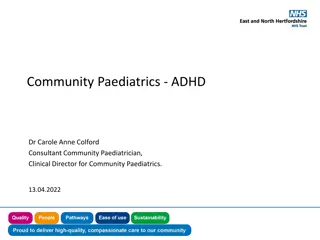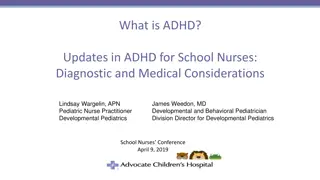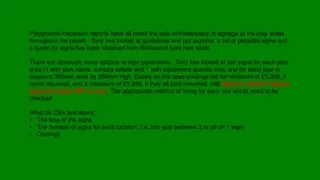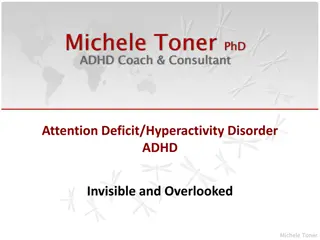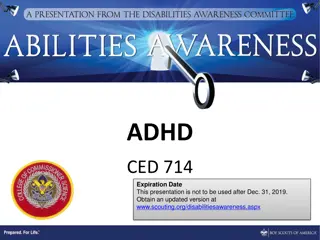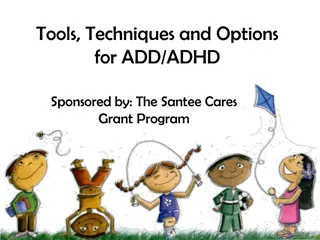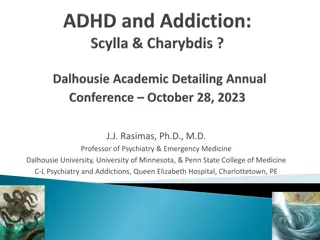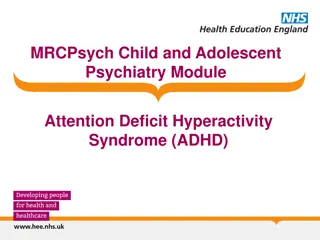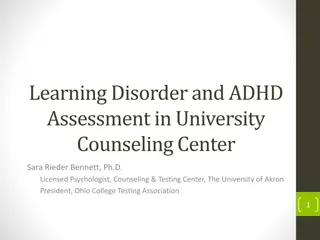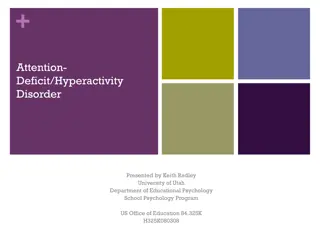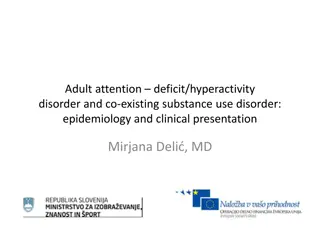Understanding ADHD: Signs, Causes, and Tips for Parents
ADHD is a common disorder affecting children's behavioral, emotional, educational, and cognitive aspects. Understanding the signs, causes, and early intervention is crucial. Factors like developmental problems and family history can contribute to ADHD. Spotting signs like inattention, organizational issues, and avoidance of tasks can help in early diagnosis and support. Farida Raj, a Special Educator, provides valuable insights and guidance for parents dealing with ADHD in their children.
Download Presentation

Please find below an Image/Link to download the presentation.
The content on the website is provided AS IS for your information and personal use only. It may not be sold, licensed, or shared on other websites without obtaining consent from the author. Download presentation by click this link. If you encounter any issues during the download, it is possible that the publisher has removed the file from their server.
E N D
Presentation Transcript
PARENT INFORMATION SERIES ATTENTION DEFICIT HYPERACTIVITY DISORDER (ADHD) WAY TO SPOT THE SIGNS UNDERSTANDING ADHD Step Step 02 04 Step Step 01 03 TIPS FOR PARENTS LEARNING IT S CAUSES Farida Raj, Special Educator
UNDERSTANDING ADHD LEARNING ITS CAUSES WAY TO SPOT THE SIGNS TIPS FOR PARENTS UNDERSTANDING ADHD At the psychologist s office he is hopping from chair to char, swinging his arms and legs restlessly fiddling with light switches. While at it he is picks up the phone and speaks to an imaginary friend and speaks non-stop. When steered by his mother to play with other children in the playroom he barges into the game and soon drifts away to do other things. Unable to entertain himself quietly he is fidgeting constantly. Abhishek is 7 years old. The parents are worried about this behavior. The psychologist hands out a diagnosis. Abhishek has Attention Deficit Hyperactivity Disorder (ADHD) Farida Raj, Special Educator
UNDERSTANDING ADHD LEARNING ITS CAUSES WAY TO SPOT THE SIGNS TIPS FOR PARENTS UNDERSTANDING ADHD ADHD is one of the most common disorders affecting behavioral, emotional, educational & cognitive aspects of a child s life. BEHAVIOURAL EMOTIONAL EDUCATIONAL COGNITIVE This causes problems in school work and peer relations. Children with ADHD have trouble with concentration and their ability to finish tasks to completion. Many children with ADHD repeat a class or drop out of school. There is any urgent need to understand this complex disorder so that effective interventions maybe planned. Farida Raj, Special Educator
UNDERSTANDING ADHD LEARNING ITS CAUSES WAY TO SPOT THE SIGNS TIPS FOR PARENTS WHAT CAUSES ADHD? There is no one specific cause for ADHD. But, few factors can help understand the increased chances of ADHD in a child. DEVELOPMENTAL PROBLEMS Drug abuse during pregnancy Head injuries during early infancy Developmental problem in the brain FAMILY HISTORY Some had it. one in the family has The causes are not comprehensive or conclusive to understand the reason your child has ADHD. No single cause can be attributed to the cause of ADHD in your child. Farida Raj, Special Educator
UNDERSTANDING ADHD LEARNING ITS CAUSES WAY TO SPOT THE SIGNS TIPS FOR PARENTS WAY TO SPOT THE SIGNS OF ADHD The child is not hyperactive or impulsive. He/she is inattentive. ADHD, INATTENTIVE TYPE Symptoms of this sub-type must be present for atleast 6months to indicate inattentive ADHD Fails to pay attention on tasks or play activities Has difficulty sustaining attention on tasks or play activities Does not listen to what is being said to him/her. Fails at schoolwork, duties (not due to oppositional behavior or failure to understand instructions) Has trouble organizing tasks Avoids or strongly dislikes tasks that require mental effort on his/her part. Looses things required to carry out a task (e.g. pencils, notebooks). Frequently distracted by outside stimuli. SPOT THE PROBLEM BEHAVIOURS TO HELP DIAGNOSE ADHD AS EARLY AS POSSIBLE Farida Raj, Special Educator
UNDERSTANDING ADHD LEARNING ITS CAUSES WAY TO SPOT THE SIGNS TIPS FOR PARENTS WAY TO SPOT THE SIGNS OF ADHD ADHD, HYPERACTIVE-IMPULSIVE TYPE The child is hyperactive or impulsive. Atleast 4 of the symptoms of this sub-type must be present for atleast 6months to indicate hyperactive-impulsive ADHD Fidgets or squirms in their seat. Leave seat in a place where he/she is expected to be seated (e.g. classroom). Difficulty planning or performing leisure activities quietly. Runs about or climbs excessively in an inappropriate manner. Blurts out answers to questions before the question has been completed. Has trouble waiting in queues or taking turns in group settings. SPOT THE PROBLEM BEHAVIOURS TO HELP DIAGNOSE ADHD AS EARLY AS POSSIBLE Farida Raj, Special Educator
UNDERSTANDING ADHD LEARNING ITS CAUSES WAY TO SPOT THE SIGNS TIPS FOR PARENTS WAY TO SPOT THE SIGNS OF ADHD ADHD, COMBINED TYPE The child is hyperactive & inattentive The child is not significantly impulsive ADHD, NOT OTHERWISE SPECIFIED (NOS) TYPE Those who do not meet the full criteria for ADHD but still present some of the symptoms. Adolescents and adults belong to this category. REMEMBER, Seizure, middle-ear infections, lack of sleep, emotional problems & learning disabilities can cause symptoms similar to ADHD. SPOT THE PROBLEM BEHAVIOURS TO HELP DIAGNOSE ADHD AS EARLY AS POSSIBLE Farida Raj, Special Educator
UNDERSTANDING ADHD LEARNING ITS CAUSES WAY TO SPOT THE SIGNS TIPS FOR PARENTS 6-PRONGED APPROACH TO MANAGING ADHD POSITIVE REINFORCEMENT Be sure to praise your child for their efforts, not just the outcomes. Practice response prevention when necessary. Taking the steps to prevent an undesirable behavior from occurring ahead of time. OBSERVE & UNDERSTAND Have reasonable expectations of your child Identify your child s strengths & build them up Discipline is key. Do not engage in parenting that leaves your child uninhibited. This can adversely impact your child s self & impulse control mechanisms. PLAY/STUDY ENVIRONMENT Provide a quiet, distraction-free, structured and stable environment to study or play in. Observe your child s temperament & stimulation from his/her environment. LOVE & CARE Children with ADHD often suffer from poor self- image. Tell your child that you love & support him/her unconditionally, and show it through a pat or a hug. An empathetic teacher can make a big difference to an ADHD child s academic progress. CONSISTENCY IS KEY ENGAGE WITH YOUR CHILD Give the child clear directions & break up assignments into smaller, simpler tasks. Channelize your child s energies in constructive physical activities. Remedial teaching and occupational therapy will help the child. Please consult with the relevant therapist for guidance. Create a fixed routine for the day. Structuring of activities is very crucial for a child with ADHD. Parents and teachers must chalk out a plan & stick with it. If a behavior is unacceptable on one day, it should not be permissible the next day.
This content has been developed in collaboration with Remedial & Special Educator Ms.Farida Raj. It has been adapted from her book ''Breaking Through" - A Hand Book for Teachers and Parents of Children with Learning Difficulties, & reproduced here with consent. NAYI DISHA RESOURCE CENTRE Join Us on Facebook Nayi Disha Resource Centre is an online information resource platform that supports families of persons with, Specific Learning Disabilities, Intellectual & Developmental Disabilities. Join Us on Twitter Join Us on Linkedin Visit us at WWW.NAYI-DISHA.ORG
